Home Wind Turbine Guide
If you’re anything like other homeowners across the nation, you dream of reducing your monthly energy bills by going green. The first step to reaching this goal is to have an energy audit done on your home. While you can guess that you’re losing climate-controlled air through your drafty windows and doors, a professional energy audit will let you know for sure about the areas in your home that need help. After you make sure that your property is adequately insulated, then it’s time for you to consider installing a wind-electric system that can cleanly and inexpensively produce power for your home. This handy guide covers the main things that you need to know about wind electricity for residential use and installing a home wind turbine.
Download the PDF form of this guide here
The History of the Wind Turbine Generator
Harnessing the wind as an energy source is nothing new — ancient mariners across the globe relied on the wind to push their sailboats. The first recorded use of a small wind turbine cropped up as early as 200 B.C. in China, where windmills pumped water into fields.
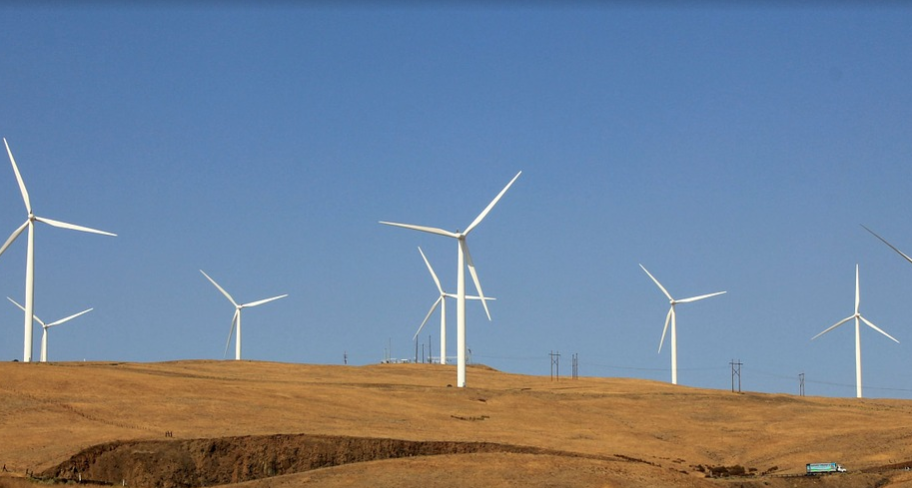
Small-scale farmers continued to utilize windmills into the Current Era, refining the technology in order to speed up and simplify food production. The windmill turbine generator traveled from the Middle East to the Netherlands and beyond, and was used to grind corn, wheat, and other grains, as well as pump water.
The windmill generator was brought to the New World sometime in the late 1800s, and American farmers harnessed the ancient methods perfected across the Atlantic. The 20th century, and the electricity revolution fueled by forward-thinking visionaries including Edison and Tesla, would bring new, exciting possibilities for the wind power generator.
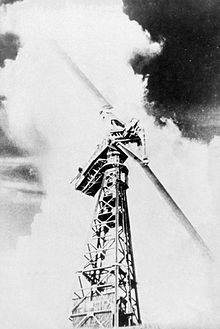
The so-called “Energy Crisis” of 1979 jump-started the modern alternative energy revolution, but the world’s first-megawatt wind generator was erected and tied to the grid in Castleton, Vermont, in 1941. The 1,250 kilowatts Smith-Putnam Wind Turbine stood at a height of 120 feet, only a few meters taller than today’s recommended home wind turbine apex.
Wind Power for Homes
Most people think of installing solar panels when they consider getting an alternative energy system. They often forget about wind power for homes. The wind is a natural resource that you can’t see, but it’s effective for power generation. While renewable power use is a popular trend today, powering devices with the help of wind is not a new concept.
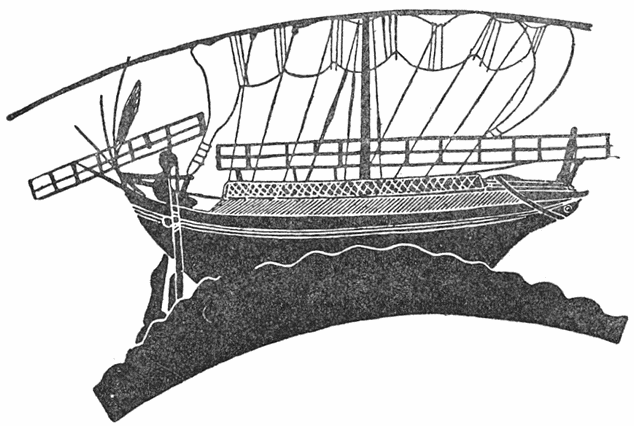
The ancient Egyptians reportedly used wind-based power to propel their sailboats on the Nile as early as 5,000 B.C., and Central Asians captured wind to power water pumps and grain mills in 200 B.C. These early windmills paved the way for modern wind turbines that are used to generate electricity for commercial and residential use.
There are two main ways that you can get wind-generated electricity for your home. You can buy wind-based electricity from an eco-friendly power company. These companies usually invest in wind farms and sell the energy that they produce to household consumers and commercial customers. This method of getting wind-based electricity for your home will not save you significant amounts of money on your monthly utility bills. Eco-friendly power companies must pay for the extensive infrastructure that is associated with owning wind farms. In most cases, purchasing electricity from one of these companies lowers your use of fossil fuel pollutants.
The most common way to get wind-generated power for your home is to install a residential wind turbine on your property. By placing a home wind electric system on your property, you’ll get the monthly savings on your energy bills and the easy conscience of a good environmental steward. Wind-derived power generation isn’t for everyone, though.
You’re a good candidate for a home wind electric system if you have these five things: A property that experiences high amounts of wind
✔️ A large lot of at least one acre
✔️ Flexible building codes that allow wind turbines
✔️ A way to connect your system to the power grid
✔️ A desire to live completely off the grid
The Department of Energy has wind resource maps that can help you find out if your property has enough wind to make an investment in a turbine feasible. You can also get informational resources about area wind speeds from your local airport.
To determine if a new wind system is right for you, you’ll have to conduct a cost-benefit analysis that is based on these four criteria:
- Your power needs
- Cost of your new wind electric system
- Expected energy production from your wind-electric system
- Projected savings amount from using the system
The Lowdown on Wind Power for Homes
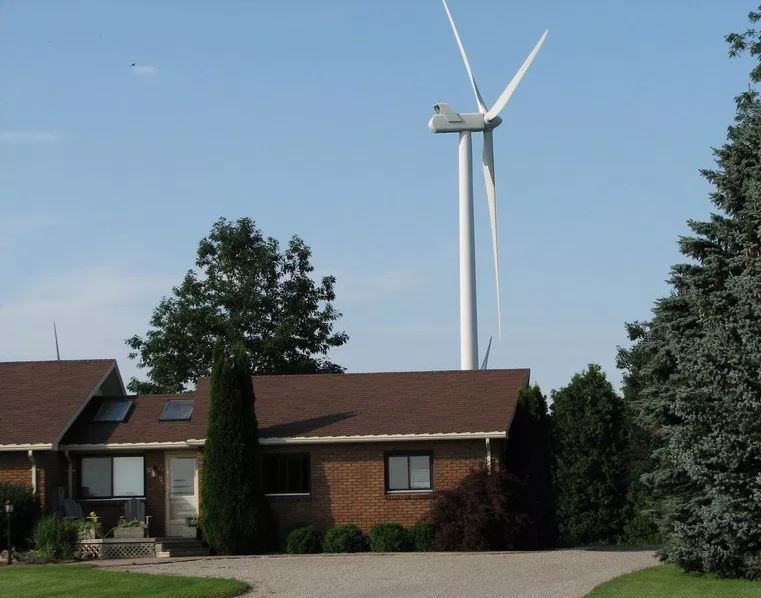
There are numerous reasons to utilize the wind as a means of producing energy. In the past few decades, wind power has risen from obscurity to become a global phenomenon, lighting up homes and businesses throughout the world, from the vast fields of China to the New Belgium Brewing facility in Fort Collins, Colorado.
This guide is designed for those new to wind power technology as well as those curious about adopting a lifestyle that doesn’t rely on the power grid. Wind turbine cost and site considerations are just part of the journey toward clean energy. The following home wind turbine information primarily focuses on grid-tied wind power systems, rather than those off the grid.
Site Considerations for Home Wind Turbine Kits
There are many factors to consider in regard to residential wind turbine placement, and your home’s geographic location is just the beginning.
The cost of wind energy is not as prohibitive as you might expect. In order for a wind turbine to be both efficient and economically feasible over the long term, it should be installed where the annual average wind speed is over 5 meters/second. Your windmill electric generator will achieve optimal power production when installed above turbulent air, where airflow is smooth and laminar: That is, the wind consistently flows in the same direction.
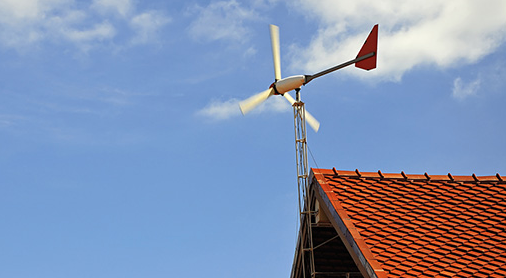
One of the biggest mistakes you can make during the installation of your residential wind turbine is placing it on a rooftop. Airflow surrounding buildings is often turbulent, resulting in insufficient power production. A rooftop wind generator tends to vibrate slightly during operation, which can damage your structure over time.
Although it may sound counter-intuitive, the presence of consistent, strong winds in a particular location doesn’t necessarily indicate that the site is ideal for wind power collection. Keep in mind that quality is vastly more important than quality where energy production is concerned, and just say no to a rooftop wind turbine.
Your local landscape is of prime importance when you’re considering the installation of a small wind turbine for your home. In the U.S., optimal wind power production conditions are found across the Great Plains, with Texas topping the list of wind-producing states, by a wide margin. The Lone Star State, in fact, out-produces all three of the country’s subsequent wind power producers — Kansas, Montana, and Nebraska — combined.
But it was a small town in Missouri that made history as the nation’s first city to be powered completely by wind energy. Rock Port, with a population of just over 1,200, accomplished the feat in June 2011. As of 2017, four more American cities joined Rock Port in the wind power revolution:
- Aspen, Colorado
- Burlington, Vermont
- Kodiak Island, Alaska
- Greensburg, Kansas
Each of these groundbreaking cities meets the minimum requirements for efficient wind generation, boasting prime annual wind speeds and low air turbulence numbers.
How Does a Wind Turbine Generate Electricity?
Today’s wind power generator strongly resembles its wooden ancestors, typically constructed with a few simple components. Grid-tied residential wind turbine kits contain a tower and three rotor blades, and other components may be included.
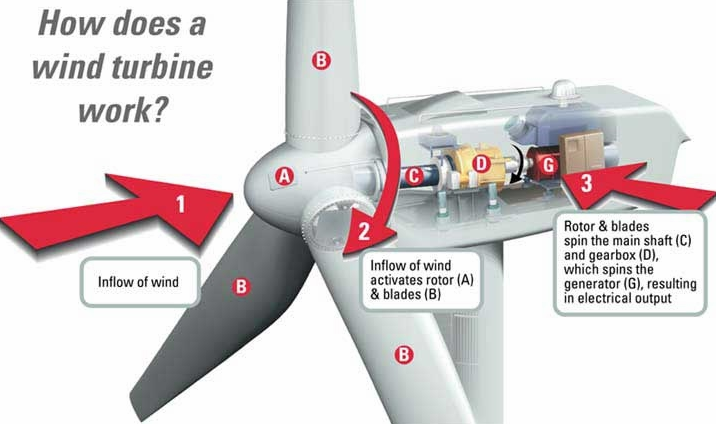
Your new wind turbine for home generates power almost effortlessly — primarily utilizing spinning rotor blades that power an alternator, which diverts power to a tough magnet. A grid tie controller is included in nearly every wind turbine kit on the market. The device ensures that your home stays connected even if your home wind generator isn’t drawing power.
To calculate the estimated annual wind production at your residence, you’ll need to determine the rotor diameter of your micro wind turbine. Then, use the following equation:
Energy [kWh] = 2.09 X Diameter2 [m] X Wind3 [m/s]
A typical single-family home uses about 8,000 kWh of energy per year. To achieve that level of wind power production at an average wind speed of 11 mph, a 6 kWh turbine should be sufficient. Calculate your household’s typical energy needs using information from past power bills in order to determine the output you’ll need from a wind turbine.
The unfortunate truth is that many locations are not ideal for the production of wind power. To determine if wind generation is a viable option for your home, you’ll need to put in the research. Gather annual wind speed statistics from your local airport, along with meteorological data.
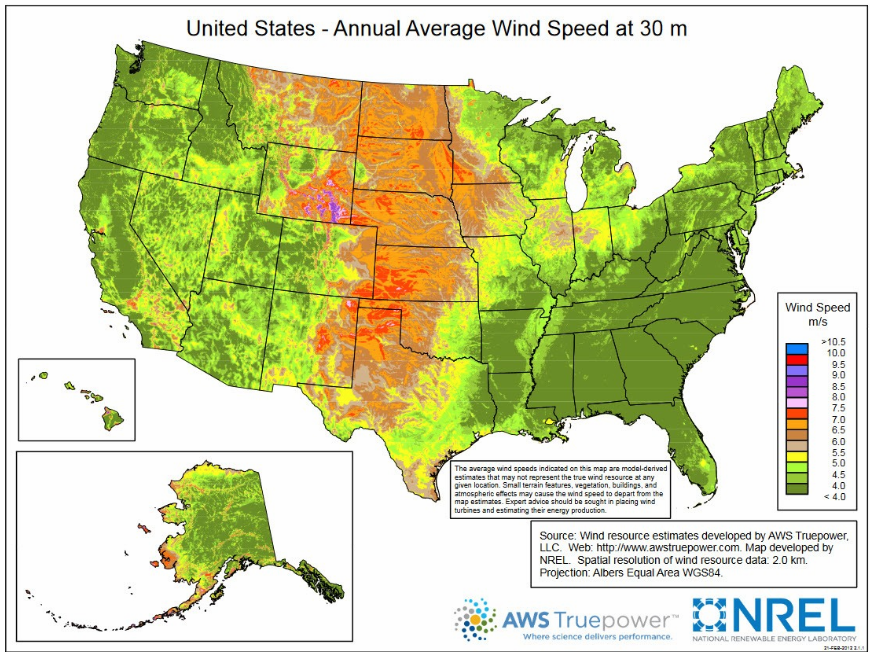
Even if the wind conditions in your area meet the minimum recommended requirements, there’s still your property to consider in regards to wind turbine cost. Trees, houses, and outbuildings all impede airflow, and even a small wind turbine should be installed at least 500 feet from the nearest structure.
As for wind turbine height, bigger is typically better. Experts recommend a minimum turbine tower height of 60 feet, plus rotor blade length, a grand total of about 100 feet from the ground.
How Much Energy Does a Wind Turbine Produce?
Wind turbines are rated by their maximum capacity to produce electricity from captured wind. Electricity production for large wind turbines, which are used in commercial applications, is measured in megawatts. One megawatt is equal to one million watts of power. Small wind turbines are designed for use on residential properties and have electricity production ratings in kilowatts. Popular small wind electric systems are rated at 10 kW. If these systems work at maximum capacity daily, they can produce 87,600 kW of electricity in a year, which is more than enough electricity to power the average American household.
When determining whether one of these systems will meet your family’s electrical needs, you’ll have to look further than the manufacturer’s maximum capacity rating, however. How much energy does a wind turbine produce? You can best answer this question by factoring in your area’s variations in airspeeds in addition to your system’s size and type. The wind is highly variable. Your area can experience high speeds for one week, but winds can taper off the next week. Industry experts suggest that a small wind electric system is only feasible if your area experiences an average wind speed of 10 mph or greater.
Look at the National Renewable Energy Laboratory wind maps for your area as a guide. When it comes to capturing the greatest amount of wind power, the configuration of your small wind electric system matters. A typical small wind electric system consists of these six main elements: – Turbine frame – Rotor – Wind power generator or DC motor – Tail – Tower – balance-of-system components The typical system has a horizontal-axis turbine that contains three rotors. The rotors capture wind and turn a shaft that supplies the system’s home wind generator or DC motor with power.
A large rotor diameter captures more wind and generates more power than a smaller version. The windmill generator capacity for your turbine is determined by the size of your system’s rotors. The tail guides the direction of the turbine and keeps it facing the wind properly. The turbine is affixed to a tower for optimal wind capture. These towers can be stand-alone or guyed. Guyed towers, which are held in place by guy wires, are the most common types of towers for small wind electric systems.
The height of these towers usually ranges from 20 feet to 60 feet. Your small wind electric system will capture more wind and have greater levels of power production if it’s positioned on a tall tower that soars above obstacles that could block wind flow. The balance-of-system components include items such as storage batteries, wiring to connect your system to the grid, a controller, and an inverter.
While you can’t predict wind speeds with precision, your small wind electric system mitigates the risk of lower speeds by storing excess energy in its batteries. If you’re located in a wind-rich area, a small wind-electric system can produce the bulk of your household’s power. These systems are suitable for single-family, suburban homes, houses that are settled on small farms, and structures that need power for water pumps.
Types of Residential Wind Turbine Systems on the Market
You can get small wind turbines in a variety of configurations. The most common small wind turbine is the horizontal axis version that contains two or three blades. These systems need high-speed winds to rotate, so it’s necessary to place them on tall towers. Full-size horizontal axis turbine systems require heavy gearboxes, generators, and blades that rely on controls to move them in the direction of the wind.
Smaller versions of horizontal-axis wind turbines exist to provide power in smaller spaces. A typical micro wind turbine comes with 52-inch diameter blades that can capture wind at speeds as low as 2.5 mph.
Micro wind systems come with batteries to store electricity and a charge controller to optimize power output. You can use a micro wind turbine for off-the-grid power production at a cabin or as backup power for your primary residence. You can get a micro wind system that includes a 600w or 400w wind turbine. A 400w wind turbine can also be used to power devices on boats and to recharge batteries.
A mini wind turbine system is another option for energy consumers who have space constraints. This wind-powered turbine produces 25 watts of power in 22 mph winds. The mini wind turbine often weighs less than 10 pounds and can be installed as a rooftop wind turbine. You can position this wind-electric turbine on your apartment balcony.
While the main components of full-size, horizontal wind generator systems are located at the top of tall towers, a vertical-axis wind turbine houses its main parts at the base of the structure. This turbine type sits vertically to the ground and perpendicular to wind streams. Vertical-axis wind turbines are often considered to be more efficient and cost-effective than horizontal wind generator systems.
A vertical wind turbine has no blades that must be positioned into oncoming winds, and it needs no special wind speed and direction sensors. The components of a vertical wind turbine are always facing winds, and they have greater surface areas for wind capture than the propeller blades of horizontal systems. They can be installed as a rooftop wind turbine or be placed in a more inconspicuous area on your property. Innovations in vertical axis turbines take the form of microsystems such as the ones produced by Vortex Bladeless.
Horizontal Versus Vertical Wind Turbine
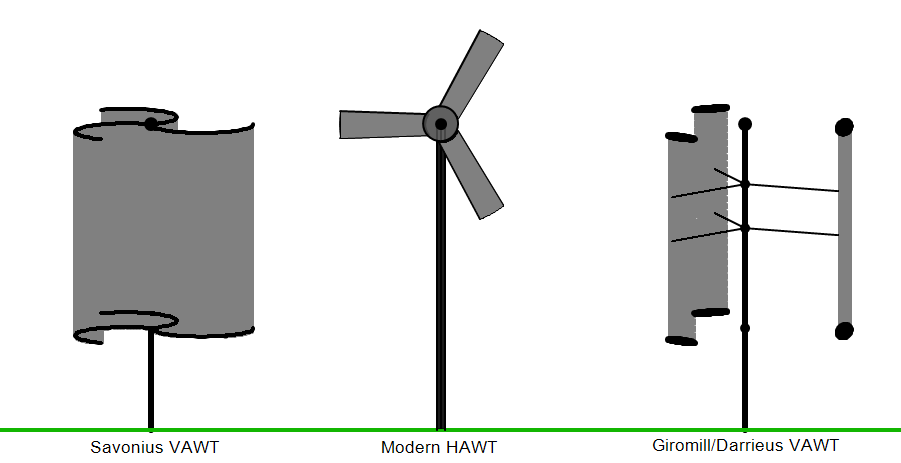
Both the traditional windmill generator used in early American food production and the massive metal behemoths that dot the foothills of Altamont Pass in Central California, an expansive array of nearly 5,000 turbines spanning 50,000 acres, are examples of Horizontal Axis Wind Turbines (HAWTs).
Horizontal turbines are outfitted with rotors that resemble a propeller, rotating on an axis that’s parallel to the ground. In today’s alternative energy market, nearly every wind power generator designed for on-grid connection rotates on a horizontal axis.
Automaxx 600W Home Wind Turbine
Last update on 2025-10-26
The general consensus within the world of wind power is that HAWTs are vastly superior to turbines that rotate vertically. The shape of a Vertical Wind Turbine resembles that of a wire whisk. Two blades rotate around a stationary vertical shaft, perpendicular to airflow.
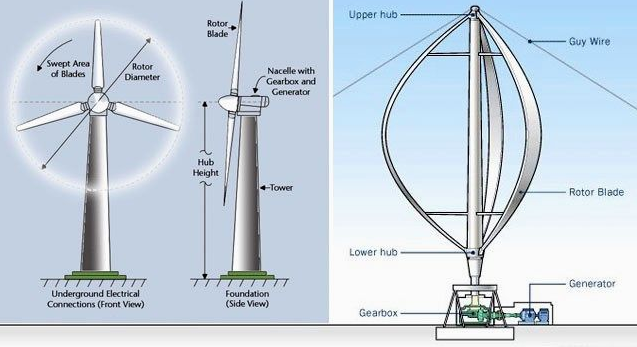
Further, vertical blade rotation causes excess wind resistance, negatively impacting the turbine’s performance and reliability. In your search for the optimal residential wind turbine for sale, don’t be fooled by false promises regarding the capability of vertical-axis turbines.
How Much Does a Home Wind Turbine Cost?
Powering your home with wind is a great way to reduce your carbon footprint along with your energy bill. But most wind turbines carry a hefty price tag: The equipment itself will set you back about $5,000 per kilowatt, meaning that you can expect to shell out about $40,000 for an 8 kWh system. You also need to factor in the cost of installation.
Self-installation of your wind turbine will likely save you money, but it’s not a good idea for most homeowners. Even if you’re a dedicated do-it-yourself person, you don’t want to risk constructing the turbine incorrectly. The turbine will also have to be tied to the local power grid, a job that’s best left to the professionals.
Expect an installation cost ranging between about $8,000 to $25,000, depending on the size of your property and the turbine itself, as well as the distance from the turbine to the power grid.
Finding the Right Home Wind Turbine for Sale
Once you’ve determined that your residence is an ideal candidate for wind turbine installation, it’s time to weigh your options. And since home wind turbine kits are a major investment, you should avoid making a hasty decision.
Read customer reviews, compare prices and specs between each wind generator kit, and don’t hesitate to contact wind turbine distributors directly with any questions about system performance, size, or estimated output. Questions to ask include, “how much energy does a wind turbine produce?”
In addition, check for certification: All wind turbines sold in the U.S. must be approved by the Small Wind Certification Council.
Wind turbine kits for home use range in capacity, size, price, and include extras. Minimalist home wind turbine kits, ideal for smaller homes, often contain only a basic turbine and grid-tie controller. Other home turbine kits are packed with accessories and amenities, boasting speeds of up to 125 mph, a lifetime guarantee, and/or the superior power of a permanent magnet rotor alternator.
No matter the reason you’ve made the switch to wind energy to power your home, you have myriad options at your fingertips. To ensure optimal wind turbine efficiency and a quick return of your investment, familiarize yourself with the perks as well as the limitations of this energy-saving technology. Welcome to the clean energy revolution!
How To Build A Home Wind Turbine
You may decide to take matters into your own hands when you consider the question, “how much does a wind turbine cost?” A DIY wind turbine will cost you much less than a wind turbine for sale at your local retailer. Learning how to make a wind turbine is relatively simple with the amount of tutorial content that’s available on the web. Without the pressure of justifying a windmill power system that costs tens of thousands of dollars, you’re free to capture the wind’s power in a manner that meets your household’s needs best. When considering DIY wind electric systems, you can get as sophisticated or as simple as you like. Consider this video tutorial of how to build a wind-electric turbine that contains three blades.
The DIY wind turbine that is featured in the “how to make a wind turbine” video that is linked above has an estimated cost of $30 and takes about six hours of labor. Other homemade wind electric systems cost more if you want an upgraded home wind generator, a new deep-cycle battery, and the wiring to connect your homemade wind turbine to the power grid.
How Wind Turbine Systems Survive Natural Disasters
You may think that hurricanes and typhoons are ideal conditions for wind energy systems. High-speed winds create windmill power that can either be used immediately or stored for later use. These natural disasters can cause harm to wind turbine generator rotors if wind speeds are too high, however. Commercial manufacturers know how to build a wind turbine that stands up to storms. These factory-made wind turbine generator systems use built-in safety mechanisms that shut off when conditions become too harsh.
Wind turbines are equipped with sensors that measure wind speed. These wind electric systems start generating electricity at a certain wind speed. It operates steadily until airspeeds exceed the system’s maximum capacity rating. If your wind turbine’s capacity rating is 55 mph, then it will likely shut off automatically to protect its rotors during a hurricane. Category five hurricanes produce sustained winds of 157 mph. A wind turbine produces electricity and is sturdy enough to survive a powerful storm system if it has been properly installed.
A home wind turbine continues to be a viable option for certain residences. New developments in wind technologies promise turbines that not only survive storms but thrive on them. Challenge, which is an alternative energy start-up in Japan, has designed a wind-electric system that captures high-speed winds from typhoons. Typhoons in Japan are common, and they typically produce winds of 100 mph or greater. The company’s new turbine design features cylinders rather than the propeller-like blades of a traditional horizontal axis wind turbine.
The Japanese company hopes to produce this safer, cleaner form of energy to offset the loss of energy production that was caused by the 2011 Fukushima accident. Prototypes of the design indicate that the Challenergy wind electric systems will be stronger than traditional systems, and they will produce greater amounts of energy during strong storms.
Other Types of Renewable Energy
Renewable energy is defined as an energy source that quickly and naturally replenishes itself. In addition to the wind, other sources of renewable power include water, solar, geothermal, biomass, and biofuels.
Water
Hydroelectric power is made when the motion of running water is turned into electricity, and it’s one of the oldest forms of renewable power on earth. Ancient farmers used water power to turn wheels to operate grain mills. Today, water currents in American rivers, streams, and waterfalls are harnessed to power homes and businesses in every state. Dams are often used to control the amount of flowing water for hydroelectric plants. Some famous dams that are used to produce hydroelectric power are the Grand Coulee Dam in Washington, the Robert Moses Niagara Power Plant in New York, and the Hoover Dam in Arizona. If your state uses hydroelectric power plants to supply most of its energy needs, your utility bills are likely to be lower than homeowners who live in other states.
Solar
Solar energy is one of the most popular sources of renewable power for homeowners who want to lower their utility bills. Sunshine is abundant in many American cities, and it’s produced daily for free. Homeowners capture the sun’s energy with solar panel systems that are usually attached to their roofs. These panels are a part of a system that supplies electricity to the home through a connection to the utility company’s power grid or as a stand-alone unit. Solar power deep cycle batteries store excess energy for later use.
Geothermal
Have you ever marveled at the geysers and hot springs at Yellowstone National Park? These natural wonders are examples of geothermal energy at work. The earth produces heat deep within its crust that can be captured for heating and cooling buildings. Geothermal energy production sites are usually found in regions that are prone to volcanic activity.
Biomass
One of the most exciting forms of renewable power is one that recycles waste products into usable power. Biomass energy is the conversion of animal and plant waste products into methane gas or ethanol for power. If society continues to produce waste from food processing, farm animals, and even human sewage, biomass energy will remain a renewable source of power. Many coal plants are converting some of their buildings into biomass processing areas to meet regulatory requirements for cleaner energy production. Local governments also support the use of landfill waste for biomass energy production.
Bio Fuels
Biofuel energy is a controversial form of renewable power that can be derived from animal or plant matter. Companies use sugarcane and corn to produce bioethanol for power. Critics of this form of biofuel argue that these plants are food crops that should be used to feed hungry people rather than powering commercial buildings, homes, and large trucks.
Lorem ipsum dolor sit amet, consectetur adipiscing elit. Ut elit tellus, luctus nec ullamcorper mattis, pulvinar dapibus leo.
Pros and Cons of Wind Energy
- Wind is free
Wind is clean, renewable power
New wind technologies being developed
Equipment is relatively simple to operate
- Wind quantity and speeds vary
Large land lots needed for system setup
Operating a wind power system is noisy
Equipment is unsightly
Some equipment is made using petroleum products
Kills bats and birds
The options are growing for those who are interested in reducing their contribution to toxic fossil fuel emissions, and wind-based power has taken center stage as a viable source of clean energy for home and commercial use. A close examination of the advantages and disadvantages of wind-based power shows how it stacks up to other forms of renewable power sources such as solar.
Pros
#1 Wind is free.
Wind is created when the sun heats the earth’s surface unequally. Air streams that touch hot surfaces rise, and air that hits a cooler surface descends. These conditions create low and high atmospheric pressure. When these air masses interact, wind is formed. One of the key benefits of wind is that it’s free.
#2 Wind is clean, renewable power.
Wind turbines produce electricity that is cleaner to develop and to use than electricity that is produced from coal and oil. Wind-derived electricity is also considered to be renewable since it can be produced in a relatively short amount of time.
#3 New wind technologies being developed.
Public and private organizations promise to continue developing wind technologies that will make wind-based power more cost effective in residential and commercial markets. New turbine designs and improved battery storage are projected for the future.
#4 Equipment is relatively simple to operate.
The design of today’s small wind turbines is patterned after windmills that have been used for millennia to power equipment. The main components of these small wind electric systems are limited in scope and easy to operate and maintain.
Cons
#1 Wind quantity and speeds vary.
Many areas of the United States don’t get enough high-speed winds to make installing windmills for electricity worthwhile. A coastal American city such as Norfolk may only get high winds during a hurricane, but Chicago has an average wind speed of 10.3 mph throughout the year.
#2 Large land lots needed for system setup.
A wind turbine that has a large rotor diameter for its turbine blades requires a spacious lot that is flat and unobstructed by forests or buildings. These wind electric systems usually perch atop tall towers to maximize their wind collecting capabilities.
#3 Operating a wind power system is noisy.
A report from General Electric lets you know about the sound pressure level at which a typical home wind turbine operates. The turbine is usually positioned about 985 feet away from a home, and it produces 43 decibels of noise at that distance. The noise that is produced by a wind power generator is a disadvantage if you have close neighbors.
#4 Equipment is unsightly.
Whether you opt for a vertical axis wind turbine or one of the horizontal varieties, you still must be prepared for a reduction in curb appeal when you install a small wind electric system.
#5 Some equipment is made using petroleum products.
Critics of wind as a renewable power source note that wind turbines have moving parts that must be lubricated with petroleum-based products. Some turbine blades are also manufactured with petroleum-based resins.
#6 Kills bats and birds.
Bats and birds are important members of the ecosystem. Birds help to pollinate crops, and bats reduce mosquito populations. The link between horizontal axis wind turbines and wildlife mortality is significant.
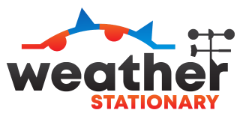
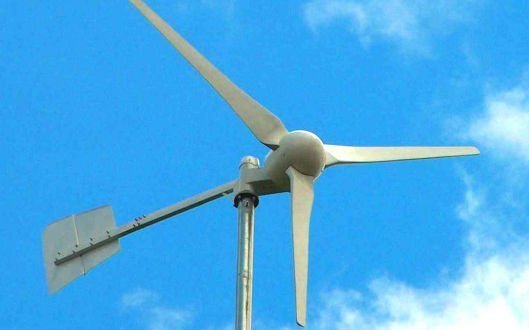

Trackbacks/Pingbacks